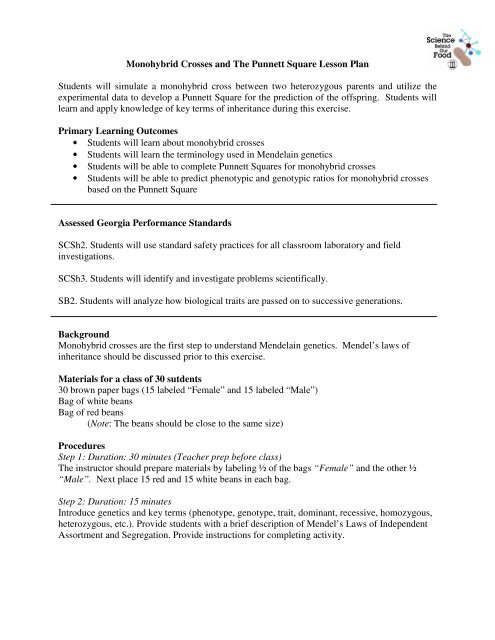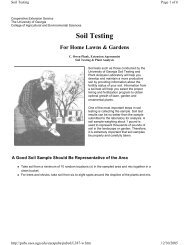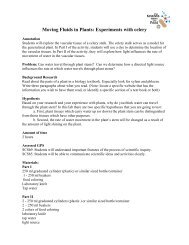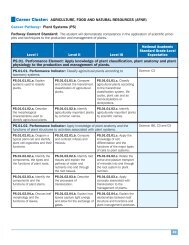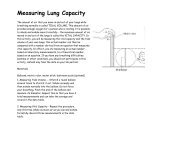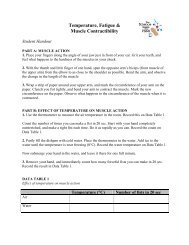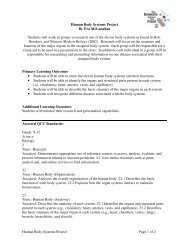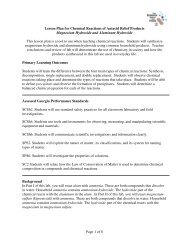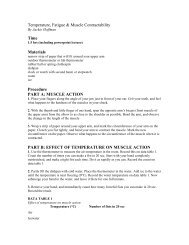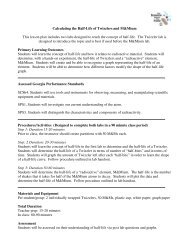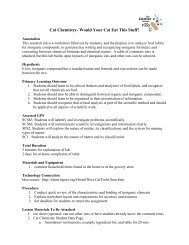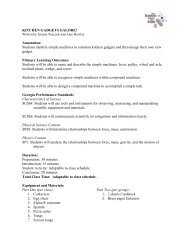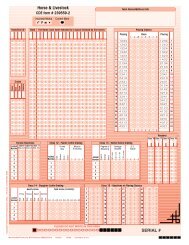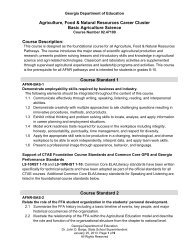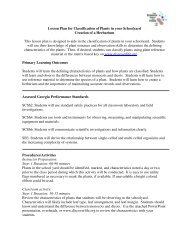Monohybrid Crosses and The Punnett Square Lesson Plan Students ...
Monohybrid Crosses and The Punnett Square Lesson Plan Students ...
Monohybrid Crosses and The Punnett Square Lesson Plan Students ...
You also want an ePaper? Increase the reach of your titles
YUMPU automatically turns print PDFs into web optimized ePapers that Google loves.
<strong>Monohybrid</strong> <strong>Crosses</strong> <strong>and</strong> <strong>The</strong> <strong>Punnett</strong> <strong>Square</strong> <strong>Lesson</strong> <strong>Plan</strong><br />
<strong>Students</strong> will simulate a monohybrid cross between two heterozygous parents <strong>and</strong> utilize the<br />
experimental data to develop a <strong>Punnett</strong> <strong>Square</strong> for the prediction of the offspring. <strong>Students</strong> will<br />
learn <strong>and</strong> apply knowledge of key terms of inheritance during this exercise.<br />
Primary Learning Outcomes<br />
• <strong>Students</strong> will learn about monohybrid crosses<br />
• <strong>Students</strong> will learn the terminology used in Mendelain genetics<br />
• <strong>Students</strong> will be able to complete <strong>Punnett</strong> <strong>Square</strong>s for monohybrid crosses<br />
• <strong>Students</strong> will be able to predict phenotypic <strong>and</strong> genotypic ratios for monohybrid crosses<br />
based on the <strong>Punnett</strong> <strong>Square</strong><br />
Assessed Georgia Performance St<strong>and</strong>ards<br />
SCSh2. <strong>Students</strong> will use st<strong>and</strong>ard safety practices for all classroom laboratory <strong>and</strong> field<br />
investigations.<br />
SCSh3. <strong>Students</strong> will identify <strong>and</strong> investigate problems scientifically.<br />
SB2. <strong>Students</strong> will analyze how biological traits are passed on to successive generations.<br />
Background<br />
<strong>Monohybrid</strong> crosses are the first step to underst<strong>and</strong> Mendelain genetics. Mendel’s laws of<br />
inheritance should be discussed prior to this exercise.<br />
Materials for a class of 30 sutdents<br />
30 brown paper bags (15 labeled “Female” <strong>and</strong> 15 labeled “Male”)<br />
Bag of white beans<br />
Bag of red beans<br />
(Note: <strong>The</strong> beans should be close to the same size)<br />
Procedures<br />
Step 1: Duration: 30 minutes (Teacher prep before class)<br />
<strong>The</strong> instructor should prepare materials by labeling ½ of the bags “Female” <strong>and</strong> the other ½<br />
“Male”. Next place 15 red <strong>and</strong> 15 white beans in each bag.<br />
Step 2: Duration: 15 minutes<br />
Introduce genetics <strong>and</strong> key terms (phenotype, genotype, trait, dominant, recessive, homozygous,<br />
heterozygous, etc.). Provide students with a brief description of Mendel’s Laws of Independent<br />
Assortment <strong>and</strong> Segregation. Provide instructions for completing activity.
Step 3: Duration: 20-30 minutes<br />
<strong>Students</strong> will complete the pre-lab definitions, conduct the activity, <strong>and</strong> answer post-lab<br />
questions as indicated on the student lab h<strong>and</strong>out at the end of this document (2 pages).<br />
Total Duration<br />
Teacher preparation: 30 minutes<br />
Class Time: 35-45 minutes<br />
Assessment<br />
<strong>Students</strong> will be assessed based on their completion of the activity. Since this activity does not<br />
take the whole class time, a worksheet on monohybrid crosses may be useful after this activity to<br />
further assess student comprehension.
Name ________________________<br />
<strong>Monohybrid</strong> <strong>Crosses</strong> <strong>and</strong> the <strong>Punnett</strong> <strong>Square</strong><br />
Introduction<br />
Scientists use a grid-like tool (<strong>Punnett</strong> <strong>Square</strong>) to make predictions about various genetic problems. <strong>The</strong><br />
<strong>Punnett</strong> <strong>Square</strong> shows only the probability of what might occur <strong>and</strong> not the actual results. Probability is the<br />
chance of something occurring. If one wants to flip a coin 100 times, since there are 2 sides to the coin, he<br />
would expect 50 heads <strong>and</strong> 50 tails. If he flips the coin 100 times, he may actually get 60 heads <strong>and</strong> 40 tails.<br />
Prediction is one thing, <strong>and</strong> actually getting the predicted results is another. <strong>The</strong> <strong>Punnett</strong> <strong>Square</strong> only shows the<br />
chances of what might occur each time the event is undertaken.<br />
Objective<br />
In this investigation, you will use a <strong>Punnett</strong> <strong>Square</strong> to predict the possible genotypes <strong>and</strong> phenotypes <strong>and</strong> their<br />
ratios from a monohybrid cross.<br />
Pre-lab questions<br />
Define the following terms:<br />
1. <strong>Punnett</strong> square - ______________________________________________________________________<br />
2. genotype - ___________________________________________________________________________<br />
3. phenotype - __________________________________________________________________________<br />
4. homozygous - ________________________________________________________________________<br />
5. heterozygous - _______________________________________________________________________<br />
6. trait - _______________________________________________________________________________<br />
7. dominant - __________________________________________________________________________<br />
8. recessive - ___________________________________________________________________________<br />
Materials<br />
• red beans<br />
• white beans<br />
• 2 small paper bags (one labeled male <strong>and</strong> the other labeled female)<br />
Procedure<br />
1. Each group of 2 students will pick up 2 paper bags filled with 15 red (R) beans <strong>and</strong> 15 white (r) beans. This<br />
represents 2 heterozygous parents (Rr x Rr).<br />
2. One student in the group will be in charge of the male bag <strong>and</strong> the other student will be in charge of the<br />
female bag.<br />
3. At the same time, each student will reach into their bag <strong>and</strong> pull out one of the beans. <strong>The</strong> only possibilities<br />
that can be made from this selection are: RR (homozygous red), Rr (heterozygous red), or rr (homozygous<br />
white). Mark the resulting genotype <strong>and</strong> phenotype in the data table.<br />
4. Return the beans back into the bag <strong>and</strong> conduct the same process 14 more times (15 total trials).
Name ________________________<br />
Data Table<br />
Trial Offspring’s Genotype Offspring’s Phenotype<br />
1<br />
2<br />
3<br />
4<br />
5<br />
6<br />
7<br />
8<br />
9<br />
10<br />
11<br />
12<br />
13<br />
14<br />
15<br />
Analysis <strong>and</strong> Conclusions<br />
1. What is the dominant trait? ________________________________________<br />
2. How do you know it is dominant? _______________________________________________________<br />
____________________________________________________________________________________<br />
3. Which one is the recessive trait? ____________________________________<br />
4. What are the genotypes of the parents? ________________________________<br />
5. What are the phenotypes of the parents? _______________________________<br />
6. Fill in the <strong>Punnett</strong> <strong>Square</strong> below using the parents given in the procedure:<br />
Male __________ X Female __________<br />
7. What is the genotypic ratio? _______________________<br />
8. What is the phenotypic ratio? ______________________


